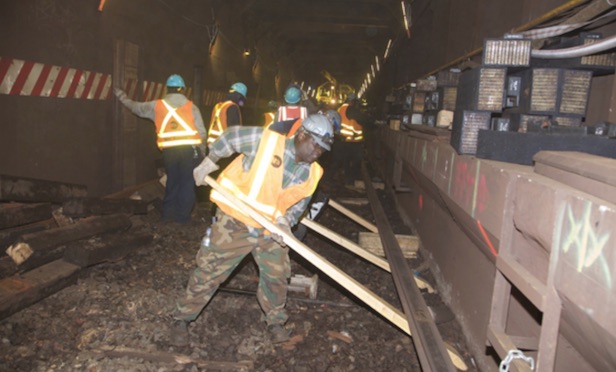 Working on the L line/ Photo credit: Lenny Wiggins, MTA New York City Transit
Working on the L line/ Photo credit: Lenny Wiggins, MTA New York City Transit
NEW YORK CITY—New York State Governor Andrew Cuomo and the Metropolitan Transportation Authority announced plans which will avoid a full shutdown of the L train. Three years ago the MTA had announced it was shutting down the L for 15 months beginning in spring 2019 to make critical repairs of infrastructure damaged by Hurricane Sandy.
But engineering experts from Columbia University and Cornell Engineering Schools provided a report with recommendations that will allow the work to be completed on nights and weekends. A singe tube will provide continued service in both directions while work is ongoing.
The engineers determined a complete closure of the L train was unnecessary.
In 2012, the 1.5 mile L train tunnel, also called the Canarsie Tunnel, which runs under the East River, was filled with corrosive salt water due to Hurricane Sandy. The 100-year-old tunnel sustained severe damage to the circuit breaker house, system and power cables and the cement wall that holds and protects cables. The work would include removing and replacing the cement benchwall and installing 126,000 feet of power cable and 176,000 feet of communications cable. The MTA had estimated the repairs would require a complete shutdown on the L train for 15 months.
In a surprise turnaround, the governor announced a new plan using new technologies and methods which would eliminate the need for a complete shutdown. The project will address long-term capacity, construct a new power substation, increase storm and flooding resiliency and upgrade the stations at Bedford Avenue in Williamsburg, Brooklyn and at First and Sixth avenues in Manhattan.
On Friday, Gov. Cuomo urged for the MTA board to hold an emergency meeting to review the new alternative plan and to allow public input. Acting MTA chair Fernando Ferrer has expressed support for the project. But Cuomo notes Ferrer had stated the MTA would have to alter current contracts with the contractors presently engaged in the tunnel's restoration.
Ferrer expressed the MTA's appreciation for the work of the engineering review team. “We have a shared goal in this effort: to make sure New Yorkers are subjected to the least possible disruptions as a result of this necessary repair work,” says Ferrer. He notes the panels recommendations would ease the strain on customers and help ensure consistently reliable service.
In anticipation of interruption to the L line, rents had declined in Northern Brooklyn earlier this year. William Walzer, a partner in the real estate department of the law firm Davidoff Hutcher & Citron, tells GlobeSt.com that tenants who signed leases that included concessions based on the anticipated L train shutdown will benefit.
“Landowners who granted the concessions won't have recourse with regard to those leases already signed but generally speaking, North Brooklyn landowners are in a good position, with property values and rents likely to resume their steady increase,” he says.
He adds developers were building higher structures in the rezoned areas in North Brooklyn, particularly near the East River, where rents have been steadily increasing from year to year.
“The impact of the L train shutdown has been looming over landlords, local businesses and the emerging office market throughout Northern Brooklyn for years now,” says Thomas Shihadeh, an agent at Marcus & Millichap who focuses on Brooklyn. “Retailers have been unable to appropriately forecast sales due to the unknown loss in foot traffic from weekend shoppers that take the L into Williamsburg or Bushwick. Office tenants have been reluctant to commit long-term as many of their employees still commute from Manhattan.”
He notes that on the residential side, the announcement is a deep sigh of relief for landlords. “The rental market has already softened in the past three to four years with anticipation of further decline in rent during the L shutdown. We would expect the softening to flatten out now that tenants can commit to a rent without the unknown hurdle of unreliable transportation.”
Although the MTA had announced transportation alternatives, Walzer says the impact of the shutdown would have been enormous. He points out that 250,000 riders travel through the Canarsie Tube every day, on trains packed to capacity during rush hour and at other times as well. “Replacing that amount of service would have been extremely difficult, even with expanded ferry and bus service and more trains on nearby lines, which themselves are nearly at full capacity,” comments Walzer.
© Touchpoint Markets, All Rights Reserved. Request academic re-use from www.copyright.com. All other uses, submit a request to [email protected]. For more inforrmation visit Asset & Logo Licensing.







